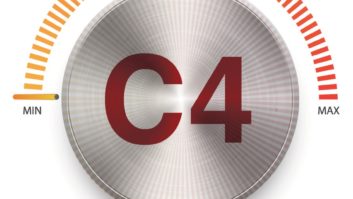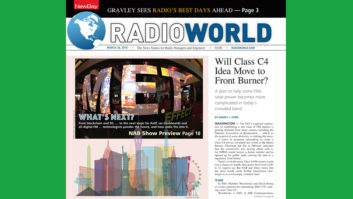WASHINGTON — The FCC’s expected exploration of establishing a new class of FM stations is gaining attention from many corners, including the National Association of Broadcasters — which, to the surprise of some observers, is resisting the move.
A notice of proposed rulemaking to create a Class C4 service circulated this winter at the Media Bureau. Chairman Ajit Pai in February indicated that the commission was moving ahead with it. An NPRM would receive a docket number and be opened up for public input, moving the idea to a regulatory front burner.

There’s no doubt many Class A FM owners would love a chance to double their power level from 6 kW to 12, experts say. But NAB and others worry that the move would create further interference challenges in an increasingly crowded band.
TO DATE
In 2014, Matthew Wesolowski and David Honig co-wrote a petition for rulemaking, RM-11727, seeking a new Class C4.
Wesolowski is CEO of SSR Communications Inc., licensee of WYAB(FM) in Flora, Miss. Honig is now president emeritus and senior advisor of the Multicultural Media, Telecom and Internet Council.
Wesolowski predicted that the change would allow for 12,000 watts of effective radiated power for about a third of the Class A FM stations now operating in Class C regions of the country. He pegs the number of stations that could upgrade in place at about 217. If tower moves within 20 km and/or community of license changes are thrown into the mix, Wesolowski said more than 700 could be eligible. Most Class A stations in the Northeast and urban centers of the Midwest would be excluded from upgrading, Wesolowski said, along with most in California.
Class A stations are limited to 6 kW ERP at 100 meters antenna height above average terrain, according to the FCC. A Class C4 station would be authorized with a power of up to 12 kW ERP, according to the proposal.
Wesolowski said he met in early March with FCC Audio Division staff to discuss his C4 proposal and concerns by some about how it could affect LPFMs and FM translators. Wesolowski said any impact on secondary services will be negligible.
“Our research found that a total of 22 LPFM and FM translator facilities could be impacted by the FM Class C4 upgrades, but in each situation, an engineering remedy existed to clear the conflict. The Audio Division has been working on their own study, which I believe will confirm our findings,” Wesolowski said.
It’s important to note that RM-11727 also calls for revising Section 73.215 of the FCC’s rules. The revision proposed by the Class C4 petition for rulemaking is to give co-channel or adjacent channel FM stations — operating in proximity to a below-maximum-facility FM station that has operated as such for at least ten years — the ability to force that below-maximum-facility FM station to accept and be locked into a Section 73.215 contour protection status unless the below-maximum-facility FM immediately upgrades to maximum facilities for its class.
One observer familiar with the request said the proposal would give co-channel and adjacent-channel FM stations the right to effectively downgrade and lock in the coverage of a below-maximum-facility FM in the same way that the FCC allowed such downgrades to Class C stations a number of years ago.
OPPOSITION
Proponents of a new C4 service believe the change would help many established FM broadcasters better serve their communities.
However, the NAB thinks the FCC would be better off addressing more pressing issues first, like finding better ways to expedite settlement of interference complaints against FM translators. Its hesitation is tied to its own petition for rulemaking filed in April 2017 seeking policy and procedural changes to increase certainty for translators and facilitate handling of interference complaints between translators and full-power FMs. That has been an issue of rising concern given the huge growth in translators as a tool of business strategy as well as AM revitalization.
The association went so far as to seek a meeting of radio leaders with Chairman Ajit Pai about the proposal in early March. Rich Kaplan, general counsel and executive VP of legal and regulatory affairs for NAB, joined NAB Joint Board Chair Caroline Beasley, who is CEO of Beasley Media Group, and Radio Board Chair Randy Gravley, president/CEO of Tri-State Communications. They asked Pai and the commission to not move forward with the Class C4 proposal. According to an ex parte filing, the broadcasters expressed the opinion that “this is not the time, if ever, to introduce another category of FM service.”
Instead, NAB would like the FCC to turn its petition into a notice of proposed rulemaking, “to help ensure the certainty of translators” to benefit millions of listeners who rely on the content they provide. NAB said in separate written comments that this idea “should certainly take priority over consideration of the Class C4 proposal, which likely will only add to the interference challenges in the marketplace.”
WHAT NEXT?
The translator landscape has changed dramatically in recent years. The NAB projects that approximately half of all AM stations will utilize FM translators once all pending applications for cross-service translators are processed. Translators also are a component in a strategy in which FM stations can gain analog footprint by feeding a translator with content from one of their HD Radio digital multicast channels.
But John Garziglia, a communications attorney at Womble Bond Dickinson who opposes the proposal, believes the broadcast industry should not trade “nominal power increases for some” while creating loss of FM translator service for others.
One legal observer speculated that Chairman Pai may use the spring NAB Show to advance the issue; but Garziglia said he’s not convinced the FCC will issue an NPRM at this point. “It could even be in the form of a notice of inquiry (NOI) rather than a NPRM — therefore asking a lot of questions but having few tentative conclusions.”
LPFM stations, which broadcast at a maximum of 100 watts, are watching too. Michi Bradley, founder of REC Networks and active in the low-power arena, said her constituency is concerned but cautiously supportive of the C4 proposal.
“The concept of a 12 kW/100 m FM broadcast service class can work for those rural areas where they can fit. I do feel that while some C4 stations may find their way near suburban areas, the spacing rules towards other stations will naturally keep them away from many of the more highly populated areas,” said Bradley. “I am still not seeing a huge gloom and doom towards LPFM stations, especially with the overprotection of full-power stations through the use of the existing LPFM buffer zone but it does have the tendencies of further increasing noise floors.”
Bradley estimates from current sites and heights that approximately 202 Class A stations would be able to upgrade under the minimum separation guidelines proposed by SSR Communications. There are probably more potential upgrades using other methods as the C4 proposal suggests, she said. Some stations may be able to upgrade from an alternate site.
“Since Class A is a catch-all service class for full-service FM stations with a service contour of 28.3 kilometers or less, there are many Class A stations in this category for several reasons including short-spacing and international protections,” Bradley said.
“This seriously brings up the question of how many of these sub old-A stations will actually upgrade and how many Class A stations that would have to relocate or install more expensive directional antennas would actually make the jump.”
Mark Lipp, a communications attorney with Fletcher, Heald & Hildreth, acknowledges some trepidation among stations owners over consequences of C4.
“Although the increase in coverage is beneficial in varying degrees, many station owners worry about interference from other stations that take advantage of the increase and thereby lose a portion of their existing coverage,” he said.
Lipp, whose firm represents several clients who could benefit from the power increase, expects to see the proposal on the FCC agenda in the next “couple of months” and thinks the delay is due to the need to offer translators, which may be impacted by the power increase, something in return such as non-adjacent channel changes if displaced by the power increase.
“The Class C4 petition has been on file for almost five years. If the FCC is favorably considering the power increase, it should have occurred before the translator applications were filed. I believe the commissioners are now aware of this conundrum and will be proposing some type of solution for the affected translator permittees and applicants,” Lipp said.
EFFICIENT USE
Another expert doesn’t envy the FCC’s balancing act of spectrum interests, but sees a new C4 service as an efficient use of FM spectrum.
AMs have had an opportunity for spectrum via FM translators, said Charles Anderson, president of Anderson Associates, a broadcast engineering firm. “The primary concern now is whether a new C4 upgrade will displace some of those FM translators. In some markets there may be an equivalent frequency to which the translator can move; however, the spectrum is very tight in and near many large and medium markets. The key consideration now is whether FM fill-in translators deserve some protection from any future C4 upgrades.”
Anderson said LPFMs do have some protection. LPFMs “cannot be displaced unless they are interfering within an FM’s 70 dBu or its city of license. It seems reasonable for some accommodation for FM fill-ins to be included with the new C4 class similar to that afforded LPFMs, although maybe not as stringent,” he said.
Jack Sellmeyer, retired president of Sellmeyer Engineering, anticipates Class A stations will be eager to explore the possibilities of higher power levels. However, he reminds station owners that twice the power doesn’t mean twice the coverage distance.
“It’s only an increase in the area covered. Terrain will play a large role in the gains. I believe the winners will be stations in a large market or any market where building penetration is a major problem for the Class As,” Sellmeyer said.
And there will likely be costs associated with a signal upgrade, Sellmeyer said.
“I suspect more than half will require new transmitters along with new transmission lines unless the antenna and line are very conservatively rated for the 6 kW level. However, if the existing facilities are adequate for the power increase and no antenna change is made in terms of height of the radiation center, the costs should be minimal; probably two to four thousand dollars for the engineering forms plus legal fees.”







